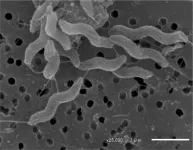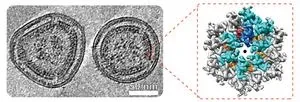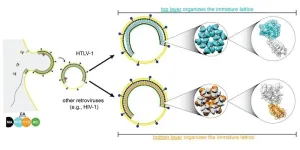Campylobacter jejuni-specific antibody gives hope to vaccine development
By targeting multiprotein molecule, antibody inhibits bacteria’s growth, pathogenicity
2024-09-25
(Press-News.org)
Bacterial infections resulting in enteritis, sometimes extra-intestinal infections such as sepsis, continue to be a global health concern. A leading cause of diarrheal and extra-intestinal infectious mortality among children under 5 and elderly persons is infection with Campylobacter bacteria, against which there is no effective vaccine or medication. An Osaka Metropolitan University-led team has recently uncovered what could be an important step toward preventing, diagnosing, and treating a species of Campylobacter bacteria.
Researchers including Professor Shinji Yamasaki and Associate Professor Noritoshi Hatanaka of the Graduate School of Veterinary Science and the Osaka International Research Center for Infectious Diseases at OMU focused on Campylobacter jejuni, the species of the bacteria that commonly causes gastroenteritis and sometimes extra-intestinal infections. Together they developed an antibody that can identify C. jejuni and inhibit the bacteria’s growth.
This monoclonal antibody reacts to a multiprotein complex known as QcrC, the expression of which is essential for the pathogenicity of C. jejuni. The QcrC molecule was found in multiple C. jejuni strains, lending high reliability to the antibody’s use in identifying the species. This molecule is also involved in energy production for C. jejuni, and the antibody acts to suppress this function, slowing the bacteria’s growth and decreasing pathogenicity.
“Our findings can lead to the development of preventive approaches so that Campylobacter infections do not become more severe, while also formulating a simple way to detect C. jejuni,” Associate Professor Hatanaka stated.
“The development of a simple detection system,” Professor Yamasaki explained, “will be useful for the rapid identification of contaminated food, which will be beneficial for the control of C. jejuni infections and food poisoning, along with vaccine development.”
The findings were published in Frontiers in Microbiology.
###
About OMU
Established in Osaka as one of the largest public universities in Japan, Osaka Metropolitan University is committed to shaping the future of society through “Convergence of Knowledge” and the promotion of world-class research. For more research news, visit https://www.omu.ac.jp/en/ and follow us on social media: X, Facebook, Instagram, LinkedIn.
END
ELSE PRESS RELEASES FROM THIS DATE:
2024-09-25
Martin Obr is on edge, anxiously waiting for his train to the airport. A storm called “Sabine” is brewing, shutting down all public transport. He catches his flight from Frankfurt to Vienna just in time.
Obr spent the last days in Germany meticulously analyzing what he calls the “perfect sample”. This sample helped him and Florian Schur from the Institute of Science and Technology Austria (ISTA) decode the structure of a virus called HTLV-1 (Human T-cell Leukemia Virus Type 1).
In collaboration with the University of Minnesota and Cornell University, ...
2024-09-25
Physics-informed virtual reality could be key to reducing the exposure of pedestrians and cyclists to harmful, non-exhaust vehicle emissions, according to a study published today (25 Sep) in the Royal Society Open Science journal.
The research lead by the University of Birmingham (supported by Rosetrees Trust and Research England QR Funding), targets the issue of major health risks and chronic diseases caused by exposure to unregulated particle pollutants from road, tyre and brake sources by providing easy, accessible guidance to the public, policy makers, and city planners, through immersive VR experiences.
Detailed ...
2024-09-25
In a compelling Genomic Press Interview published in Brain Medicine on September 25, 2024, Professor Hermona Soreq of the Hebrew University of Jerusalem in Israel unveils the profound implications of her groundbreaking research on the cholinergic system and small RNA regulators in brain-body communication.
Prof. Soreq, holder of the Endowed Slesinger Professorship of Molecular Neuroscience, has dedicated her career to unraveling the complexities of the parasympathetic nervous system, with a particular focus on acetylcholine's role in stress responses and neurodegenerative diseases. Her work has revolutionized our understanding of how the brain ...
2024-09-25
Will modern coral reefs go extinct? The answer is uncertain, but some of their ancient counterparts managed to dodge a bullet — for a while, at least.
Scientists from Osaka Metropolitan University have discovered that ancient reef-building organisms called stromatoporoids survived the Late Devonian mass extinction event and continued to thrive as major reef-builders long after their presumed extinction. These findings shed light on how life on Earth has responded to past environmental changes, offering ...
2024-09-25
The global production of plastics and the resulting plastic waste has increased to such an extent that plastics have become ubiquitous in our environment. Plastics of various sizes are also found along the German North Sea and Baltic coasts. Previous studies of microplastic pollution on German beaches have often been limited to a few locations. In the citizen science project “Microplastic Detectives”, researchers from the Alfred Wegener Institute, together with citizens, have now collected samples from beaches along the entire German coast to be analyzed for microplastics. The resulting dataset is the first to be large enough to ...
2024-09-25
Sunlight filters through the canopy of pines, holly, sweet gum, and red maple while bird calls echo in the distance. These coastal forests may seem like others in the Mid-Atlantic, but a hidden challenge looms. Standing tall next to their salt marsh neighbors, where the wind carries the sharp scent of sulfidic seawater, these trees are more than just part of the landscape—they are living monuments to a rapidly changing environment. As sea levels rise, the future of these forests is uncertain. While the adjacent salt marshes can adapt to encroaching waters, the trees, vulnerable to the increasing frequency ...
2024-09-25
Noise from aircraft at night is linked with disturbed sleep quality and sleep-wake cycle, a new study using movement trackers has shown.
Environmental health experts at the University of Leicester combined measurements from activity monitors and self-reported sleep information for the first time to put together a more detailed picture of how aircraft noise impacts sleep, in the largest such study to date.
The results, published in Environmental Health Perspectives, show that people exposed to higher levels of night-time aircraft noise experienced more restlessness during sleep and disruption in daily sleep rhythm, even if they had a full night’s sleep.
The team was led from the ...
2024-09-25
If you’d stopped monitoring the Adriatic Sea’s marine life in the mid-20th century, the outlook would have been promising. Snails and the clams they hunt for food increased in abundance for several decades during the late 1800s and early 1900s, evidence of a vibrant and healthy ecosystem.
Then, a threshold was crossed. Populations of both predator and prey abruptly plummeted and in some cases disappeared entirely. They were replaced by the common corbulid clam (Varicorbula gibba), which has the ability to slow down its metabolism in unfavorable conditions. Whenever paleontologists find an abundance of this species in the marine fossil record, it often means ...
2024-09-25
KANEOHE, HI (Sept 24, 2024 1:05 p.m. HST)- In a study published today in Proceedings of the Royal Society B, researchers at the UH Hawaiʻi Institute of Marine Biology (HIMB) Toonen- Bowen “ToBo” Lab have identified scenarios under which eight of the most common species of coral found in Hawaiʻi can adapt to and survive ocean warming and acidification. The corals in the study are prevalent throughout the Indo-Pacific, a region that comprises more than two-thirds of the coral reefs on planet Earth, and were found to be capable of surviving a “low ...
2024-09-24
Around 1 in 3 children and teens around the world is short (near)-sighted, with the global prevalence of myopia set to top 740 million cases by 2050 in this age group, finds a pooled data analysis of the available evidence, published online in the British Journal of Ophthalmology.
Female sex, East Asian or urban area residence, and educational level all seem to be key factors influencing prevalence, the findings indicate.
Short (near)-sightedness (myopia), which describes difficulty seeing objects at a distance, typically starts in early childhood and tends to worsen with age, explain the researchers. It has emerged ...
LAST 30 PRESS RELEASES:
[Press-News.org] Campylobacter jejuni-specific antibody gives hope to vaccine development
By targeting multiprotein molecule, antibody inhibits bacteria’s growth, pathogenicity










